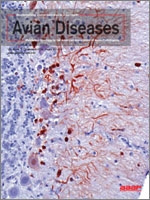BioOne.org will be down briefly for maintenance on 14 May 2025 between 18:00-22:00 Pacific Time US. We apologize for any inconvenience.
Articles (4)
Review Articles (2)
Regular Articles (11)
Research Notes (4)
Case Reports (4)
Erratum (1)

No abstract available
No abstract available
Antimicrobial Sensitivity of Avibacterium paragallinarum Isolates from Four Latin American Countries
No abstract available
